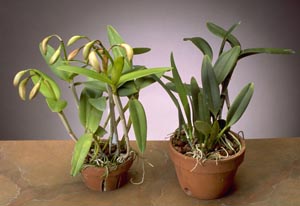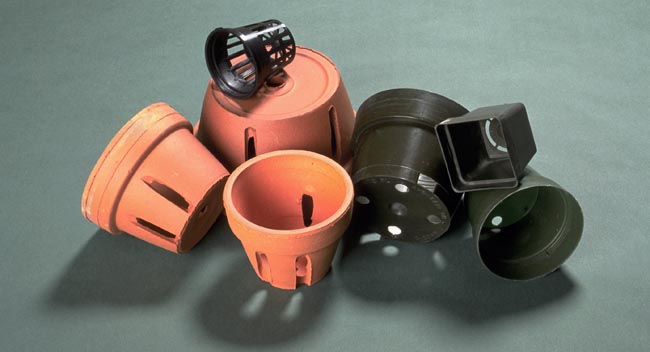|
Welcome to the AOS Beginner's Newsletter. We will be sending you monthly tips on how to grow orchids and help you get them to bloom again. In addition to the information presented here, we invite you to visit the AOS website at www.aos.org and check out the information found under ORCHID INFORMATION > ORCHID BASICS.
Putting It All Together
When we first began these beginner newsletters a year ago, we told you that we were heading toward revealing the key to growing orchids...that golden nugget of knowledge that would enable you to grow your orchids to their fullest potential. We are there! Growing orchids well involves maintaining a proper balance of cultural elements.
The best orchid growers instinctively know that if they increase or decrease one of these elements, they will have to adjust the others accordingly. We would love to think that there is a "magic bullet," a secret fertilizer or potting mix that will make our orchids grow bigger and better and flower more profusely, but in the end, it all boils down to observation and understanding what your plants are telling you so that you can maintain a balance of cultural elements.
 Bright light and increased water and fertilizer can result in rapid growth, providing that all cultural elements are kept in balance.
Providing ample light is essential for good orchid culture. Each orchid has its own optimal range of light which is commonly measured in foot candles. The AOS culture sheets will give you a good idea of the light requirements of various orchids. Growing an orchid at the high end of its light tolerance will produce stronger growths that will have the potential to flower more profusely. Plants grown "hard" can also have better cold tolerance and pest and disease resistance. HOWEVER, growing an orchid in very bright light requires that you keep the other elements in balance or else you will unnecessarily stress the plant, perhaps even kill it. That means that you will need to provide more water and fertilizer to accommodate the increased rate of photosynthesis that the higher light intensity creates, and increase air movement and humidity to keep leaf temperatures down to prevent sunburn. Achieving this goal must be done gradually and requires keen observation. Growing orchids bright carries with it the attendant considerations of excessive fertilizer salt buildup and rapid decay of potting media, both of which can damage orchid roots. Of course, these can be addressed by choice of potting media and regular flushing of pots with fresh, clean water.
We often do not have much of a choice where we grow our orchids. Orchid hobbyists are a dedicated bunch though and once bitten by the orchid "bug," will set up a growing space in a basement, patio, spare bedroom, or under a tree in Florida. Perhaps you are one of those who are limited to the low light conditions of a windowsill or under lights. Your plants will photosynthesize at a lower rate than the bright-light plants mentioned above, so you will want to adjust your other cultural factors downward. You will not need to water or fertilize as frequently and air movement and humidity will need to be just enough to prevent a stale atmosphere that will discourage leaf diseases and botrytis on flowers. Pests can have a picnic on the soft tissue of low-light orchids so you will want to be on the lookout for mealybugs, aphids and scale and treat appropriately and quickly when discovered.

An easy way to regulate how long an orchid retains moisture is by choice of pot.
One of the easiest variables used to balance orchid culture is potting. We can control how often plants need to be watered by choice of pot and media. If we have a busy schedule and cannot water our plants more than once every week or ten days, we can maintain moisture at the roots by using a water-retentive media such as sphagnum moss in a plastic pot. On the other hand, if we harbor a need to water and feel that watering often is an essential part of growing orchids, we can use a coarse, open media such as large fir bark or an aggregate in a clay pot. Or go even further toward the dry side by mounting on cork, which requires almost daily watering. With experience, the orchid hobbyist can accurately "dial in" their potting regimen to suit their culture by pot choice and the amount of drainage material used in the bottom of the pot. Styrofoam peanuts or broken chunks of styrofoam packaging have become popular as drainage and can keep the inside of a pot remarkably dry. You can use more styrofoam and the pot will dry more quickly, or use more media and the pot will stay moist longer. Clay versus plastic can be used to fine tune the hygrometric properties of a potted orchid. We can also tailor our potting to suit the needs of individual orchids. That is, mount dry-growing orchids such as Rhyncholaelia glauca and pot in sphagnum moss cloud forest species such as Dendrobium lawesii.
In future newsletters we will cover how to understand what the appearance of our orchids tells us about their health.

Guarianthe skineri 'Reba Friedland' is an example of a plant that has been
grown and flowered to its fullest potential.
Greg Allikas
June 2010
|

